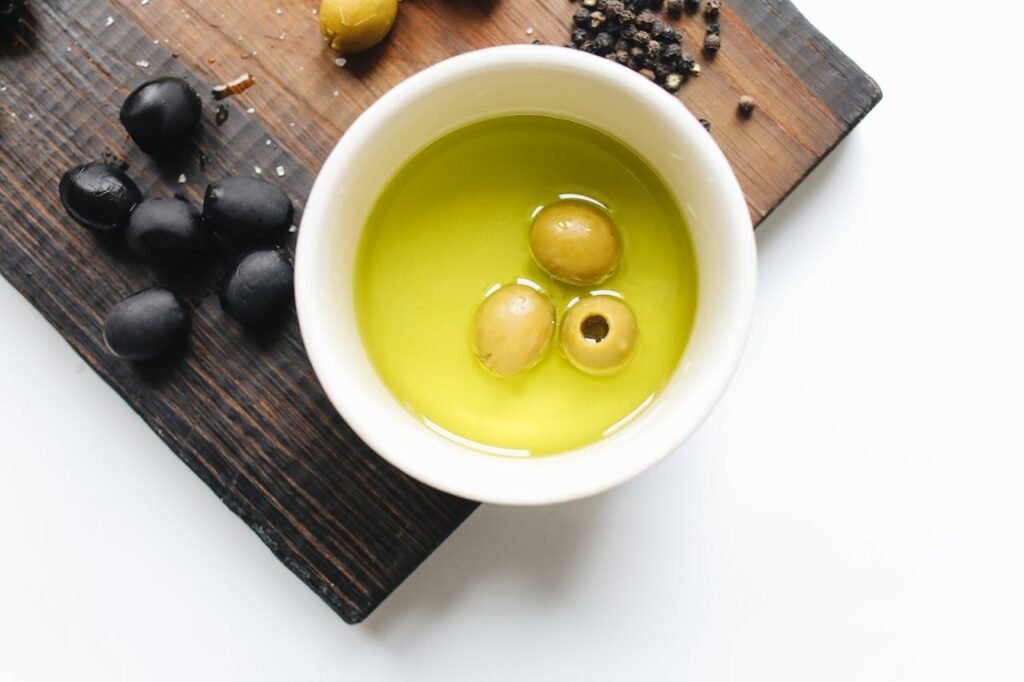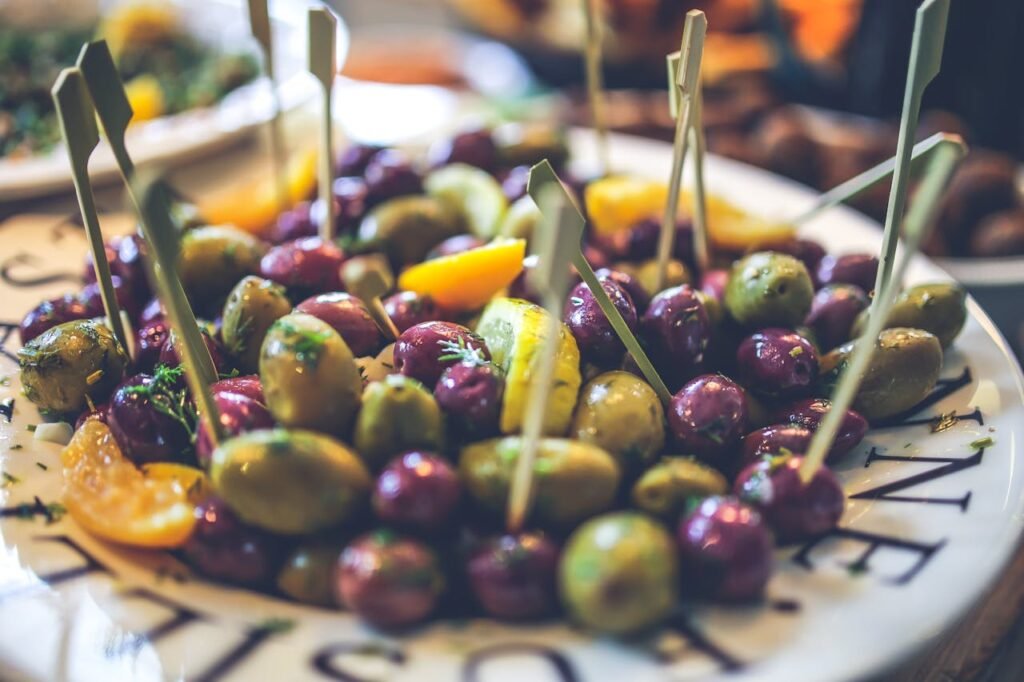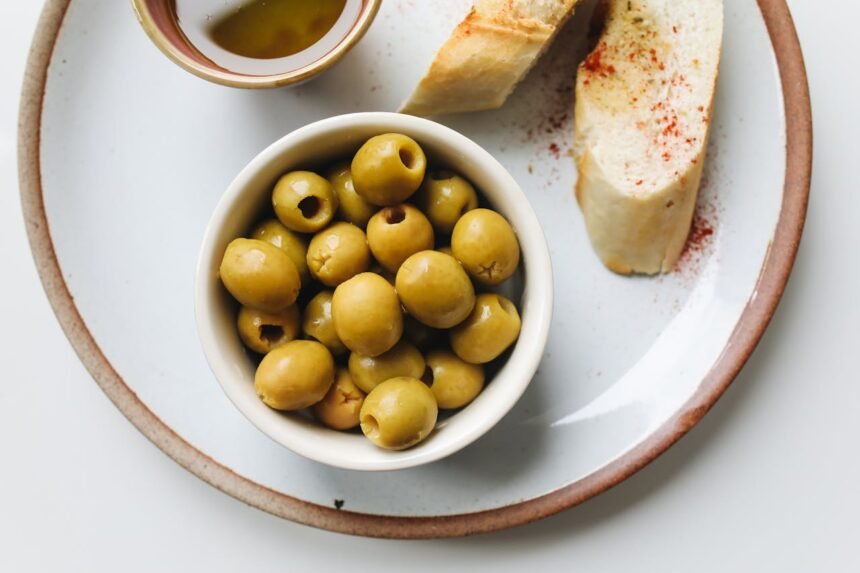Discover the surprising truth about olives! This blog post delves into the age-old question: Are olives a fruit? We explore the botanical classification, culinary uses, and nutritional profile of olives to unravel this tasty mystery. Learn why these savoury morsels are technically fruits, despite their unconventional flavour and use in cooking.
From their unique anatomy to their rich history, we’ll cover everything you need to know about olives as fruits. Whether you’re a food enthusiast, a curious learner, or simply love olives, this post will give you a fresh perspective on this Mediterranean staple. Join us as we journey through the fascinating world of olives and challenge your preconceptions about what defines a fruit!
Based on the search results from Healthline.com, here are 5 relevant internal link recommendations for your page about “Are Olives a Fruit”:
- Anchor text: “nutritional benefits of olives”
Link to: https://www.healthline.com/nutrition/foods/olives - Anchor text: “olives and weight management”
Link to: https://www.healthline.com/nutrition/are-olives-fattening - Anchor text: “Mediterranean diet recipes featuring olives”
Link to: https://www.healthline.com/health/food-nutrition/Mediterranean-diet-recipes - Anchor text: “health benefits of olive oil”
Link to: https://www.healthline.com/nutrition/11-proven-benefits-of-olive-oil - Anchor text: “kalamata olives nutrition and benefits”
Link to: https://www.healthline.com/nutrition/kalamata-olives
These recommendations provide relevant information related to olives, their nutritional content, health benefits, and culinary uses. The suggested anchor texts and link destinations offer additional value to readers interested in learning more about olives as a fruit and their role in a healthy diet.
Introduction: The Olive Conundrum
Are olives a fruit? This question might seem simple at first glance, but it often leaves people scratching their heads. Olives are a staple in Mediterranean cuisine and are widely used in various dishes and products worldwide. However, their classification as a fruit is not always obvious. In this article, we’ll explore the botanical nature of olives and answer the burning question: are olives truly a fruit?
The Botanical Definition: Are Olives a Fruit According to Science?
To determine if olives are a fruit, we must first understand the botanical definition of a fruit. In botanical terms, a fruit is the seed-bearing structure that develops from the ovary of a flowering plant after fertilisation. With this definition in mind, let’s examine olives more closely.
Olives are indeed fruits from a botanical perspective. They develop from the ovary of the olive tree’s flower and contain a seed, known as the pit or stone. Olives belong to a specific category of fruits called drupes, which are fleshy fruits with a hard stone encasing the seed[1]. Other examples of drupes include peaches, cherries, and mangoes.
So, scientifically speaking, the answer to “Are olives a fruit?” is a resounding yes. However, this classification might surprise many people who are accustomed to thinking of olives as a savoury food item rather than a fruit.
Culinary Classification: Are Olives a Fruit in the Kitchen?
While botanically olives are fruits, their culinary classification is often different. In the culinary world, fruits are typically sweet and eaten as desserts or snacks, while vegetables are usually savoury and used in main courses. This distinction leads to some confusion when it comes to olives.
In cooking and gastronomy, olives are often treated more like vegetables due to their savoury flavour profile. They’re commonly used in salads, pasta dishes, and as a topping for pizzas. Olives are rarely used in sweet dishes or eaten as a dessert fruit.
This culinary classification doesn’t change the fact that olives are botanically fruits, but it does explain why many people might not think of them as such in everyday contexts.
Nutritional Profile: Are Olives a Fruit in Terms of Nutrition?
When considering whether olives are a fruit from a nutritional standpoint, it’s important to look at their composition. Olives have a unique nutritional profile that sets them apart from many other fruits:
- High fat content: Unlike most fruits, olives are high in healthy fats, particularly monounsaturated fats.
- Low sugar content: Most fruits are known for their natural sugars, but olives contain very little sugar.
- Rich in antioxidants: Like many fruits, olives are packed with beneficial antioxidants.
- Good source of vitamins and minerals: Olives provide vitamins E and K, as well as iron and copper.
This nutritional profile makes olives more similar to avocados (another fruit often mistaken for a vegetable) than to typical sweet fruits like apples or oranges[3].
Historical and Cultural Perspectives: Are Olives a Fruit in Different Cultures?
The perception of olives as a fruit varies across different cultures and historical periods. In Mediterranean cultures, where olive trees have been cultivated for thousands of years, olives have always been recognised for their fruit status. Ancient Greeks and Romans considered olives a valuable fruit, using them for food, oil, and religious purposes.
However, in cultures where olives were introduced later or are less common, they might not be readily thought of as fruits. This cultural variation in perception adds another layer to the question “Are olives a fruit?”

Table: Comparing Olives to Other Fruits and Vegetables
| Characteristic | Olives | Typical Fruits | Typical Vegetables |
|---|---|---|---|
| Botanical Classification | Fruit (Drupe) | Fruit | Varies |
| Sugar Content | Low | High | Low |
| Fat Content | High | Low | Low |
| Culinary Use | Savoury | Sweet | Savoury |
| Eaten Raw | Sometimes | Often | Sometimes |
FAQs About “Are Olives a Fruit?”
- Q: Can olives be considered a vegetable?
A: While olives are botanically a fruit, they are often used like vegetables in cooking due to their savoury flavour. - Q: Are all olives fruits, or just certain types?
A: All olives, regardless of their variety or colour, are fruits. - Q: Why don’t olives taste sweet like other fruits?
A: Olives contain very little sugar and are high in bitter compounds, giving them their distinctive savoury taste. - Q: Are olive oil and other olive products considered fruit products?
A: Yes, since olives are fruits, products derived from them, including olive oil, are considered fruit products. - Q: How does the classification of olives as a fruit affect their use in diets?
A: Understanding that olives are fruits can help in properly categorising them in balanced diets, especially for those following specific dietary guidelines.
Conclusion: The Fruity Truth About Olives
In conclusion, are olives a fruit? The answer is unequivocally yes from a botanical standpoint. Olives develop from the olive tree’s flower and contain a seed, meeting the scientific definition of a fruit. However, their culinary use and nutritional profile set them apart from what we typically think of as fruits.
Understanding that olives are fruits can change our perspective on this versatile food. It highlights the complexity of food classification and reminds us that nature doesn’t always fit into the neat categories we create. Whether you enjoy olives in your salad, on your pizza, or straight from the jar, you can now appreciate them not just for their delicious taste, but also for their unique status in the fruit world.
So, the next time someone asks, “Are olives a fruit?”, you can confidently answer yes and share the fascinating journey of discovery that led to this conclusion.
Certainly! I’ll continue the article with additional sections to provide more depth and information on the topic “Are Olives a Fruit?”:
The Olive Tree: Source of the Fruity Debate
To fully understand why olives are fruits, we need to explore the olive tree itself. The olive tree (Olea europaea) is an evergreen tree native to the Mediterranean region. These trees are known for their longevity, with some specimens living for over a thousand years. But are olives a fruit that comes from just any part of this ancient tree?
Olive trees produce small, white flowers in the spring. These flowers, if pollinated, develop into the olives we know and love. This process of flower-to-fruit development is a key characteristic that defines olives as fruits. The transformation from flower to olive takes several months, during which the fruit grows and changes colour.
Interestingly, the colour of olives doesn’t necessarily indicate their ripeness. Green olives are harvested earlier in the season, while black olives are allowed to ripen fully on the tree. Both green and black olives are fruits, just at different stages of maturity.
The Anatomy of an Olive: Dissecting the Fruit Question
To further answer the question “Are olives a fruit?”, let’s examine the anatomy of an olive:
- Exocarp: This is the outer skin of the olive.
- Mesocarp: The fleshy part of the olive that we typically eat.
- Endocarp: The hard pit or stone that contains the seed.
This structure is typical of drupes, a subcategory of fruits that includes peaches, plums, and cherries. The presence of a single seed encased in a hard endocarp is a defining characteristic of drupes and further confirms that olives are indeed fruits.
Olive Varieties: A Fruitful Diversity
When discussing whether olives are a fruit, it’s worth noting the incredible diversity within the olive family. There are hundreds of olive cultivars, each with unique characteristics:
- Kalamata: A large, almond-shaped Greek olive with a smooth, meaty texture.
- Manzanilla: A Spanish olive, often used in martinis.
- Niçoise: Small, dark olives from France with a rich, nutty flavour.
- Castelvetrano: Bright green Sicilian olives known for their buttery taste.
Each of these varieties, despite their differences in size, colour, and taste, are all fruits. This diversity showcases the adaptability of the olive as a fruit and its importance in various cuisines around the world.
The Journey from Tree to Table: Processing Olives as Fruits
Understanding how olives are processed can shed light on why they might not be immediately recognised as fruits. Unlike many fruits that can be eaten straight from the tree, olives require processing before consumption. Are olives a fruit that can be enjoyed right off the branch?
Raw olives contain a compound called oleuropein, which gives them an intensely bitter taste. To make them palatable, olives undergo a curing process. This can involve:
- Brine-curing: Soaking in salt water
- Dry-curing: Packing in salt
- Lye-curing: Using a lye solution
- Water-curing: Soaking in water over several weeks
This processing requirement is unusual for a fruit and contributes to the confusion about olive classification. However, it doesn’t negate their status as fruits; it simply makes them a unique member of the fruit family.
Olives in World Cuisines: A Fruit with Savoury Applications
The use of olives in various world cuisines further blurs the line between fruit and vegetable in the culinary world. Are olives a fruit that’s used like other fruits in cooking? Not typically. Here are some examples of how olives are used in different cuisines:
- Mediterranean: Olives are a cornerstone of the Mediterranean diet, used in salads, pasta dishes, and as a table snack.
- Middle Eastern: Olives are often served as part of a mezze platter or used in dishes like tagines.
- American: In the US, olives are popular on pizzas and in martinis.
- South American: Countries like Argentina and Chile use olives in empanadas and other savoury dishes.
This savoury usage contrasts with how we typically use fruits in cooking, which are often featured in sweet dishes or eaten raw as snacks.

Health Benefits: The Fruity Goodness of Olives
Recognising olives as fruits can help us better appreciate their health benefits. Like many fruits, olives are packed with nutrients:
- Heart health: The monounsaturated fats in olives can help reduce bad cholesterol levels.
- Antioxidants: Olives contain powerful antioxidants that combat oxidative stress in the body.
- Anti-inflammatory properties: Compounds in olives have been shown to have anti-inflammatory effects.
- Bone health: Olives contain calcium and other minerals that support bone health.
These health benefits align with what we expect from fruits, reinforcing the answer to “Are olives a fruit?” from a nutritional perspective.
Conclusion: Embracing Olives as Unique Fruits
In conclusion, the question “Are olives a fruit?” has a clear answer: yes, they are. Botanically, culinarily, and nutritionally, olives occupy a unique space in the world of fruits. They challenge our preconceptions about what a fruit should look, taste, and feel like.
Understanding olives as fruits enriches our appreciation for their versatility and nutritional value. It reminds us that nature’s categories are often more fluid than our rigid classifications suggest. So the next time you enjoy an olive, whether it’s on a pizza, in a salad, or straight from the jar, remember that you’re savouring a fruit – one with a rich history, diverse uses, and a complex flavour profile that sets it apart in the fruit world.
Olives prove that fruits can be savoury, that they can require processing, and that they can play a central role in cuisines around the world. They are a testament to the diversity of nature and the culinary arts. So, are olives a fruit? Absolutely – and they’re one of the most fascinating fruits you’ll ever encounter.
Certainly! I’ll continue the article with additional sections to provide even more depth and information on the topic “Are Olives a Fruit?”:
The Olive’s Journey Through History: A Fruit of Civilization
The question “Are olives a fruit?” takes on new dimensions when we consider their historical significance. Olives have been cultivated for thousands of years, with evidence of olive oil production dating back to 6000 BCE. This long history has cemented olives as a fruit of great cultural importance.
Ancient civilizations revered the olive tree and its fruit:
- Greeks: Considered the olive tree a gift from the goddess Athena.
- Romans: Used olive oil as currency and a symbol of wealth.
- Egyptians: Buried pharaohs with olive branches as a symbol of life.
This reverence for olives as a fruit extended beyond their culinary use. Olive branches have long been symbols of peace, and olive oil has been used in religious ceremonies across various faiths. The olive’s status as a fruit has thus been intertwined with human civilization for millennia.
The Science of Olive Cultivation: Growing a Unique Fruit
Understanding how olives are grown further illuminates their nature as fruits. Are olives a fruit that’s easy to cultivate? Not necessarily. Olive trees require specific conditions to thrive:
- Climate: They prefer Mediterranean climates with mild winters and long, warm summers.
- Soil: Well-drained soil is crucial for olive trees.
- Water: While drought-tolerant, olive trees need adequate water for fruit production.
- Pruning: Regular pruning is essential for maintaining fruit quality and quantity.
Olive trees typically begin producing fruit after 5-8 years, but they can live and produce fruit for centuries. This longevity is unusual among fruit trees and contributes to the olive’s unique status in the fruit world.
Olive Oil: The Liquid Gold from a Fruit
No discussion about olives as fruits would be complete without mentioning olive oil. Are olives a fruit that can produce one of the world’s most valuable culinary oils? Indeed, they are. Olive oil production is a testament to the olive’s status as a fruit:
- Harvesting: Olives are carefully harvested when they reach the right stage of ripeness.
- Crushing: The entire olive fruit, including the pit, is crushed into a paste.
- Malaxing: The paste is slowly mixed to allow oil droplets to combine.
- Separation: The oil is separated from water and solids.
The result is extra virgin olive oil, often referred to as “liquid gold.” This process, which uses the entire fruit, is unique among fruits and showcases the olive’s versatility.
Olives in Modern Nutrition: A Fruit for Health-Conscious Diets
In today’s health-conscious world, the question “Are olives a fruit?” takes on new significance. Olives and olive oil are central to the Mediterranean diet, which is renowned for its health benefits:
- Heart health: The monounsaturated fats in olives can help reduce the risk of heart disease.
- Weight management: Despite being high in fat, olives can be part of a weight-loss diet due to their satiating properties.
- Cancer prevention: Some studies suggest that compounds in olives may have anti-cancer properties.
- Brain health: The antioxidants in olives may help protect against cognitive decline.
These health benefits highlight the importance of recognizing olives as fruits and incorporating them into a balanced diet.
The Environmental Impact of Olive Cultivation
As we consider whether olives are a fruit, it’s also worth examining their environmental impact. Olive cultivation has both positive and negative effects on the environment:
Positive impacts:
- Olive trees are drought-resistant and can prevent soil erosion.
- They provide habitats for various species.
- Olive groves can act as carbon sinks, helping to mitigate climate change.
Negative impacts:
- Intensive olive farming can lead to soil degradation.
- Pesticide use in some olive groves can harm biodiversity.
- Water-intensive irrigation methods can strain local water resources.
Sustainable olive farming practices are being developed to maximize the benefits while minimizing the drawbacks of olive cultivation.
The Future of Olives: Innovations in Fruit Science
The future of olive cultivation and use is an exciting area that continues to expand our understanding of this unique fruit. Researchers are exploring various aspects:
- Genetic studies: Scientists are mapping the olive genome to develop more resilient and productive varieties.
- Sustainable practices: New farming methods are being developed to reduce the environmental impact of olive cultivation.
- Health research: Ongoing studies are investigating the potential health benefits of olive compounds.
- Culinary innovations: Chefs and food scientists are finding new ways to use olives and olive oil in cuisine.
These advancements continue to affirm the olive’s status as a fruit of great importance and potential.
Olives in Art and Literature: A Fruit that Inspires
The olive’s status as a fruit has inspired artists and writers for centuries. From ancient Greek pottery depicting olive harvests to Van Gogh’s paintings of olive groves, olives have been a subject of artistic expression. In literature, olive trees often symbolize peace, wisdom, and resilience.
This artistic and literary presence underscores the cultural significance of olives as fruits that transcend mere culinary use.
Table: Olives Compared to Other Drupes
| Characteristic | Olives | Peaches | Cherries | Plums |
|---|---|---|---|---|
| Taste | Savoury | Sweet | Sweet | Sweet |
| Typical Use | Savoury dishes | Desserts | Snacks/Desserts | Snacks/Desserts |
| Oil Content | High | Low | Low | Low |
| Eaten Raw | Rarely | Often | Often | Often |
| Processing Required | Yes | No | No | No |
Conclusion: The Multifaceted Fruit
In conclusion, the question “Are olives a fruit?” opens up a fascinating exploration of botany, culture, history, and cuisine. Olives are indeed fruits, but they are fruits that challenge our preconceptions and expand our understanding of what a fruit can be.
From their ancient origins to their modern applications, olives have played a unique role in human civilization. They are fruits that nourish us, heal us, inspire us, and connect us to our past. Their classification as fruits reminds us of the diversity of nature and the complexity of our relationship with food.
Whether you’re enjoying olives as a snack, cooking with olive oil, or admiring an olive grove, remember that you’re interacting with a fruit that has shaped human history and continues to influence our culture and cuisine. Olives may not fit the typical fruit mold, but that’s precisely what makes them so fascinating and valuable.
So, are olives a fruit? Yes, they are – and they’re a fruit unlike any other, deserving of our appreciation and continued exploration.
Certainly! Here’s an expanded FAQ section addressing common questions about olives as fruits:
FAQs: Are Olives a Fruit?
- Q: Are olives technically a fruit or a vegetable?
A: Olives are technically a fruit. Botanically, they are classified as drupes, a type of fruit that has a fleshy outer layer surrounding a pit or stone. - Q: Why are olives considered a fruit if they don’t taste sweet?
A: The classification of olives as a fruit is based on their botanical structure, not their taste. Fruits are defined by how they develop from the flower of a plant, not by their flavour profile. - Q: Can olives be eaten raw like other fruits?
A: While olives can technically be eaten raw, they are extremely bitter due to a compound called oleuropein. This is why olives are typically cured before consumption. - Q: Are all types of olives fruits?
A: Yes, all varieties of olives, regardless of their colour or size, are classified as fruits. - Q: Is olive oil considered a fruit product?
A: Yes, since olive oil is extracted directly from olives, which are fruits, it is considered a fruit product. - Q: Are olives a fruit in all culinary traditions?
A: While botanically a fruit, olives are often treated as a vegetable or condiment in many culinary traditions due to their savoury flavour. - Q: Do olives count towards my daily fruit intake?
A: While olives are fruits, their nutritional profile is quite different from most fruits. They’re not typically counted towards daily fruit intake in dietary guidelines. - Q: Are olives related to other fruits?
A: Olives are distantly related to other stone fruits (drupes) like cherries, peaches, and plums, but they have a unique flavour and nutritional profile. - Q: Can people with fruit allergies eat olives?
A: Olive allergies are rare, and most people with fruit allergies can safely eat olives. However, it’s always best to consult with a healthcare professional. - Q: Are olives a fruit that can be used in desserts?
A: While uncommon, olives can be used in some dessert recipes. Their unique flavour can add complexity to sweet dishes when used creatively. - Q: How do olives compare nutritionally to other fruits?
A: Unlike most fruits, olives are high in healthy fats and low in sugar. They also contain unique antioxidants not found in many other fruits. - Q: Are olive leaves considered part of the fruit?
A: No, olive leaves are not part of the fruit. Only the fleshy part surrounding the pit is considered the fruit. - Q: Can you grow olives from the pits like other fruits?
A: While it’s possible to grow olive trees from pits, it’s a lengthy and unreliable process. Most olive trees are propagated through cuttings. - Q: Are there any sweet varieties of olives?
A: While some olive varieties are less bitter than others, there are no naturally sweet olives. All olives require curing to reduce their bitterness. - Q: How long does it take for an olive tree to produce fruit?
A: Olive trees typically begin producing fruit after 5-8 years, but it can take up to 65-80 years for them to reach peak productivity.
Remember, while olives are botanically classified as fruits, their unique characteristics set them apart from what we typically think of as fruits in everyday life.






